A Saponification Method for Chlorophyll Removal from Microalgae Biomass as Oil Feedstock
Abstract
:1. Introduction
2. Results
2.1. Traditional Bleaching Methods for Crude Scenedesmus Oil
2.2. Selection of the Optimal Method for Chlorophyll Removal from the Dried Biomass
2.3. Effects of the Chlorophyll Removal Process on Biochemical Composition of Biomass
2.4. Effects of the Chlorophyll Removal Process on Morphology and Ultrastructure of Cells
2.5. Fatty Acid (FA) Composition and Lipid Fractionation of De-Chlorophyll Oil
2.6. Pigment Composition of De-Chlorophyll Oil
2.7. Prediction of Biodiesel Quality Based on FA Composition
2.8. Preparation of Sodium Copper Chlorophyllin (SCC)
3. Discussion
4. Materials and Methods
4.1. Microorganisms and Culture Conditions
4.2. Experimental Design
4.3. Morphological and Ultrastructural Observation
4.4. Removal Efficiency of Chlorophyll in the Dried Biomass
4.5. Biochemical Composition Determination
4.6. Total Lipids Extraction from the Chlorophyll Reduced Biomass by 100% Ethanol
4.7. Lipid Classification and FA Composition
4.8. Analysis of Pigments Composition and Content in Microalgae Oil
Cb = 34.09 × A652.4 − 15.28 × A665.2
Total carotenoids = (1000 × A470 − 1.63 × Ca − 104.96 × Cb)/221
4.9. The Implications for Biodiesel Quality
| SFAs: CN = −107.71 + 31.126n − 2.042n2 + 0.0499n3 | (4) |
| MUFAs: CN = 109 − 9.292n + 0.354n2 | |
| PUFAs: CN = −21.157 + (7.965 − 1.785db + 0.235db2)n − 0.099n2 | |
| CN of biodiesel: CN = 1.068∑(CNi × mi) − 6.747 |
4.10. Preparation of SCC and Its Quality Detection
4.11. Statistical Analysis
5. Conclusions
Supplementary Materials
Acknowledgments
Author Contributions
Conflicts of Interest
Abbreviations
| CN | cetane number |
| CFPP | cold filter plugging point |
| DW | dry weight |
| EU | Europe Union |
| FA | fatty acid |
| FDA | Food and Drug Administration |
| GLs | glycolipids |
| IV | iodine value |
| LCSF | long-chain saturated factor |
| MUFAs | mono-unsaturated fatty acids |
| NLs | neutral lipids |
| PLs | phospholipids |
| PUFAs | ploy-unsaturated fatty acids |
| SCC | sodium copper chlorophyllin |
| SEM | scanning electron microscope |
| SFAs | saturated fatty acids |
| SMC | sodium magnesium chlorophyllin |
| SV | saponification value |
| TEM | transmission electron microscope |
References
- Hu, Q.; Sommerfeld, M.; Jarvis, E.; Ghirardi, M.; Posewitz, M.; Seibert, M.; Darzins, A. Microalgal triacylglycerols as feedstocks for biofuel production: Perspectives and advances. Plant J. 2008, 54, 621–639. [Google Scholar] [CrossRef] [PubMed]
- Mata, T.M.; Martins, A.A.; Caetano, N.S. Microalgae for biodiesel production and other applications: A review. Renew. Sustain. Energy Rev. 2010, 14, 217–232. [Google Scholar] [CrossRef]
- Ramluckan, K.; Moodley, K.G.; Bux, F. An evaluation of the efficacy of using selected solvents for the extraction of lipids from algal biomass by the soxhlet extraction method. Fuel 2014, 116, 103–108. [Google Scholar] [CrossRef]
- Garcia, A.L. Algae Biorefinery: An Experimental Study on Liquid Fuels Production and Nutrients Recycling. Ph.D. Thesis, Universiteit Twente, Enschede, The Netherlands, 2013. [Google Scholar]
- Hosikian, A.; Lim, S.; Halim, R.; Danquah, M.K. Chlorophyll extraction from microalgae: A review on the process engineering aspects. Int. J. Chem. Eng. 2010, 2010. [Google Scholar] [CrossRef]
- Aronoff, S. The chemistry of chlorophyll. In Die CO2-Assimilation/The Assimilation of Carbon Dioxide; Pirson, A., Ed.; Springer: Berlin/Heidelberg, Germany, 1960; Volume 5, pp. 234–251. [Google Scholar]
- Kulkarni, M.G.; Dalai, A.K.; Bakhshi, N.N. Utilization of green seed canola oil for biodiesel production. J. Chem. Technol. Biotechnol. 2006, 81, 1886–1893. [Google Scholar] [CrossRef]
- Diosady, L.L. Chlorophyll removal from edible oils. Int. J. Appl. Sci. Eng. 2005, 2, 81–88. [Google Scholar]
- Issariyakul, T.; Dalai, A.K. Biodiesel Production from Greenseed Canola Oil. Energy Fuels 2010, 24, 4652–4658. [Google Scholar] [CrossRef]
- Levadoux, W.L.; Kalmokoff, M.L.; Pickard, M.D.; GrootWassink, J.W.D. Pigment removal from canola oil using chlorophyllase. J. Am. Oil Chem. Soc. 1987, 64, 139–144. [Google Scholar] [CrossRef]
- Park, J.-Y.; Choi, S.-A.; Jeong, M.-J.; Nam, B.; Oh, Y.-K.; Lee, J.-S. Changes in fatty acid composition of Chlorella vulgaris by hypochlorous acid. Bioresour. Technol. 2014, 162, 379–383. [Google Scholar] [CrossRef] [PubMed]
- Baroi, C.; Dalai, A.K. Simultaneous esterification, transesterification and chlorophyll removal from green seed canola oil using solid acid catalysts. Catal. Today 2013, 207, 74–85. [Google Scholar] [CrossRef]
- Bahmaei, M.; sadat Sabbaghian, E.; Farzadkish, E. Development of a method for chlorophyll removal from canola oil using mineral acids. J. Am. Oil Chem. Soc. 2005, 82, 679–684. [Google Scholar] [CrossRef]
- Ghazani, S.; Marangoni, A. Minor components in canola oil and effects of refining on these constituents: A review. J Am. Oil Chem. Soc. 2013, 90, 923–932. [Google Scholar] [CrossRef]
- Przybylski, R.; Mag, T.; Eskin, N.A.M.; Mc Donald, B.E. Canola Oil. In Bailey’s Industrial Oil and Fat Products, 6th ed.; Shahidi, F., Ed.; Wiley-Interscience: Hoboken, NJ, USA, 2005. [Google Scholar]
- Christaki, E.; Florou-Paneri, P.; Bonos, E. Microalgae: A novel ingredient in nutrition. Int. J. Food Sci. Nutr. 2011, 62, 794–799. [Google Scholar] [CrossRef] [PubMed]
- Sathish, A.; Sims, R.C. Biodiesel from mixed culture algae via a wet lipid extraction procedure. Bioresour. Technol. 2012, 118, 643–647. [Google Scholar] [CrossRef] [PubMed]
- Chen, L.; Liu, T.; Zhang, W.; Chen, X.; Wang, J. Biodiesel production from algae oil high in free fatty acids by two-step catalytic conversion. Bioresour. Technol. 2012, 111, 208–214. [Google Scholar] [CrossRef] [PubMed]
- Ferruzzi, M.G.; Blakeslee, J. Digestion, absorption, and cancer preventative activity of dietary chlorophyll derivatives. Nutr. Res. 2007, 27, 1–12. [Google Scholar] [CrossRef]
- Rodriguez-Amaya, D.B. A Guide to Carotenoid Analysis in Foods; ILSI Press: Washington, DC, USA, 2001. [Google Scholar]
- Yuan, J.-P.; Chen, F. Chromatographic Separation and Purification of trans-Astaxanthin from the Extracts of Haematococcus pluvialis. J. Agric. Food Chem. 1998, 46, 3371–3375. [Google Scholar] [CrossRef]
- Granado, F.; Olmedilla, B.; Gil-Martinez, E.; Blanco, I. A Fast, Reliable and Low-cost Saponification Protocol for Analysis of Carotenoids in Vegetables. J. Food Compos. Anal. 2001, 14, 479–489. [Google Scholar] [CrossRef]
- Pasquet, V.; Chérouvrier, J.-R.; Farhat, F.; Thiéry, V.; Piot, J.-M.; Bérard, J.-B.; Kaas, R.; Serive, B.; Patrice, T.; Cadoret, J.-P.; et al. Study on the microalgal pigments extraction process: Performance of microwave assisted extraction. Process Biochem. 2011, 46, 59–67. [Google Scholar] [CrossRef]
- Burja, A.M.; Armenta, R.E.; Radianingtyas, H.; Barrow, C.J. Evaluation of fatty acid extraction methods for Thraustochytrium sp. ONC-T18. J. Agric. Food Chem. 2007, 55, 4795–4801. [Google Scholar] [CrossRef] [PubMed]
- Kobayashi, T.; Tanabe, I.; Obayashi, A. On the properties of the starch granules from unicellular green algae. Agric. Biol. Chem. 1974, 38, 941–946. [Google Scholar] [CrossRef]
- Buléon, A.; Colonna, P.; Planchot, V.; Ball, S. Starch granules: Structure and biosynthesis. Int. J. Biol. Macromol. 1998, 23, 85–112. [Google Scholar] [CrossRef]
- Fernández-Reiriz, M.J.; Perez-Camacho, A.; Ferreiro, M.J.; Blanco, J.; Planas, M.; Campos, M.J.; Labarta, U. Biomass production and variation in the biochemical profile (total protein, carbohydrates, RNA, lipids and fatty acids) of seven species of marine microalgae. Aquaculture 1989, 83, 17–37. [Google Scholar] [CrossRef]
- Rausch, T. The estimation of micro-algal protein content and its meaning to the evaluation of algal biomass I. Comparison of methods for extracting protein. Hydrobiologia 1981, 78, 237–251. [Google Scholar] [CrossRef]
- Stansell, G.; Gray, V.; Sym, S. Microalgal fatty acid composition: Implications for biodiesel quality. J. Appl. Phycol. 2012, 24, 791–801. [Google Scholar] [CrossRef]
- Carr, R. Refining and degumming systems for edible fats and oils. J. Am. Oil Chem. Soc. 1978, 55, 765–771. [Google Scholar] [CrossRef]
- Zhou, X.; Xia, L.; Ge, H.; Zhang, D.; Hu, C. Feasibility of biodiesel production by microalgae Chlorella sp. (FACHB-1748) under outdoor conditions. Bioresour. Technol. 2013, 138, 131–135. [Google Scholar] [CrossRef] [PubMed]
- Hanagata, N.; Dubinsky, Z. Secondary carotenoid accumulation in Scenedesmus komarekii (Chlorophyceae, Chlorophyta). J. Phycol. 1999, 35, 960–966. [Google Scholar] [CrossRef]
- Aydin, M.E.; Farag, A.A.M.; Abdel-Rafea, M.; Ammar, A.H.; Yakuphanoglu, F. Device characterization of organic nanostructure based on sodium copper chlorophyllin (SCC). Synth. Met. 2012, 161, 2700–2707. [Google Scholar] [CrossRef]
- Shi, Y.; Yan, G.; Li, Y. Research on the extraction technology of chlorophyll from silkworm excrement. Anim. Husb. Feed Sci. 2009, 4, 78–80. [Google Scholar]
- Whittick, A. Handbook of phycological methods. Developmental and cytological methods. Phycologia 1981, 20, 217–218. [Google Scholar] [CrossRef]
- Lichtenthaler, H.K. Chlorophylls and carotenoids: Pigments of photosynthetic biomembranes. Methods Enzymol. 1987, 148, 350–382. [Google Scholar]
- Li, T.; Wan, L.; Li, A.; Zhang, C. Responses in growth, lipid accumulation, and fatty acid composition of four oleaginous microalgae to different nitrogen sources and concentrations. Chin. J. Oceanol. Limnol. 2013, 31, 1306–1314. [Google Scholar] [CrossRef]
- Khozin-Goldberg, I.; Shrestha, P.; Cohen, Z. Mobilization of arachidonyl moieties from triacylglycerols into chloroplastic lipids following recovery from nitrogen starvation of the microalga Parietochloris incisa. BBA Mol. Cell Biol. Lipids 2005, 1738, 63–71. [Google Scholar] [CrossRef] [PubMed]
- Dubois, M.; Gilles, K.A.; Hamilton, J.K.; Rebers, P.A.; Smith, F. Colorimetric method for determination of sugars and related substances. Anal. Chem. 1956, 28, 350–356. [Google Scholar] [CrossRef]
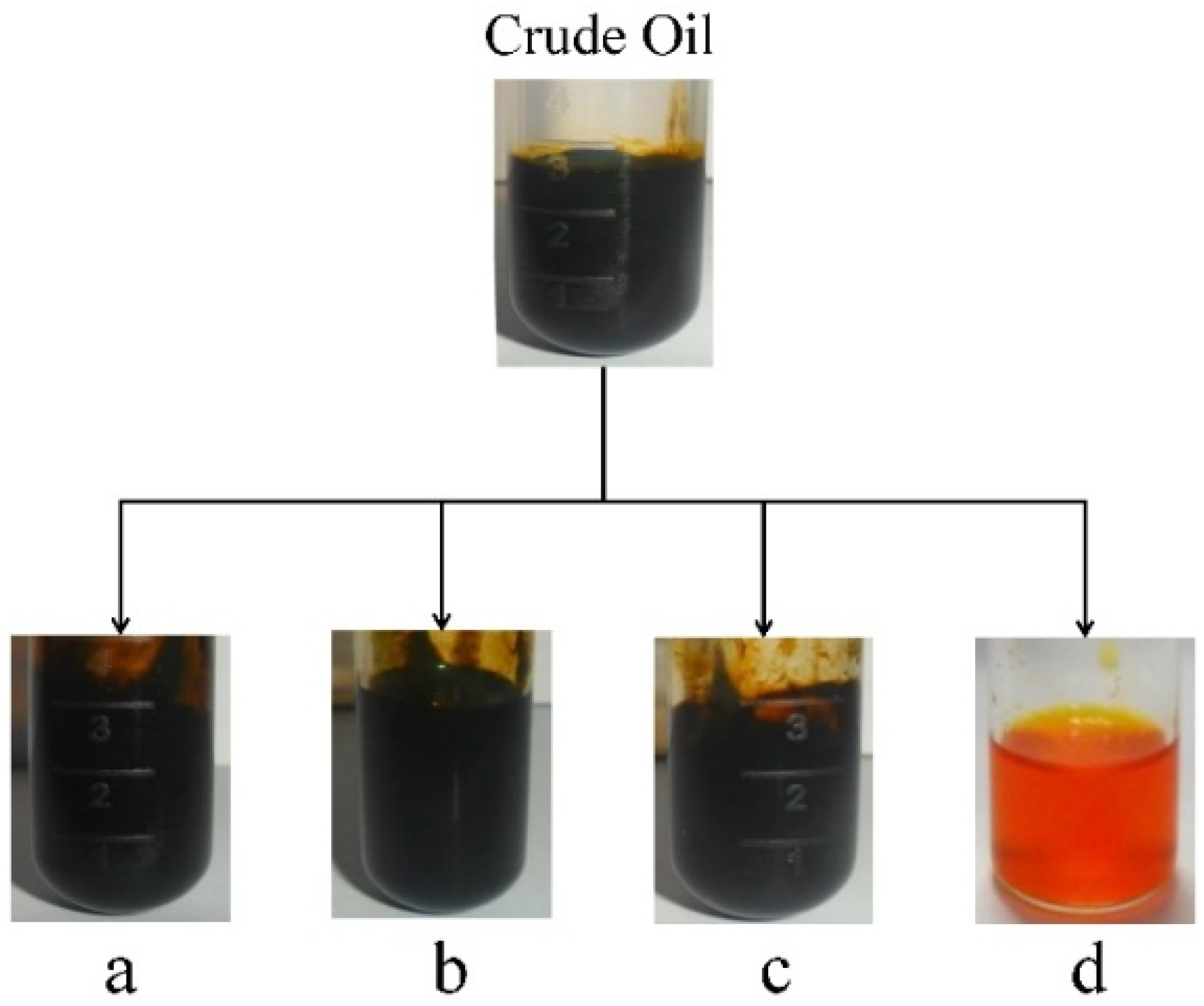
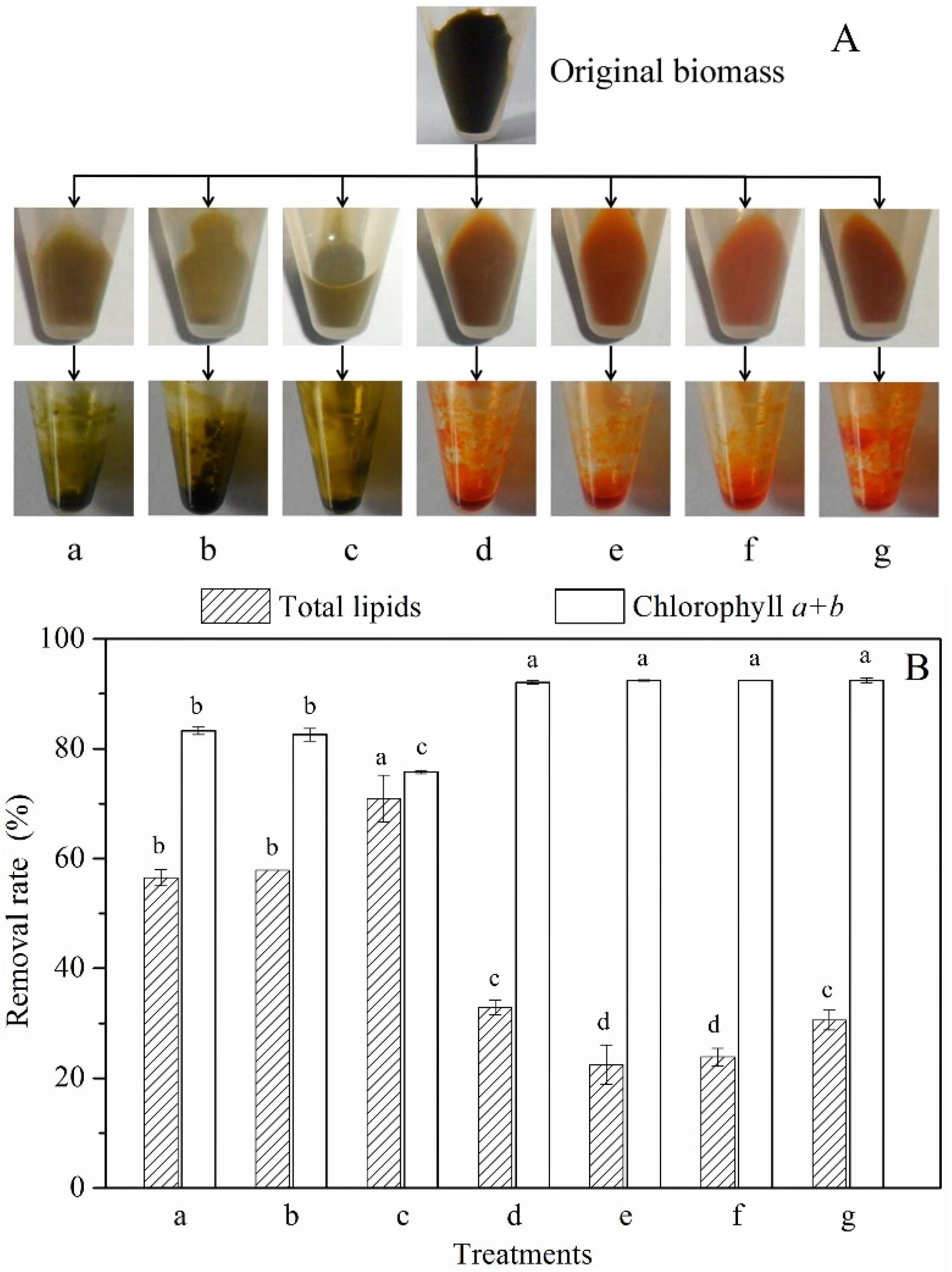


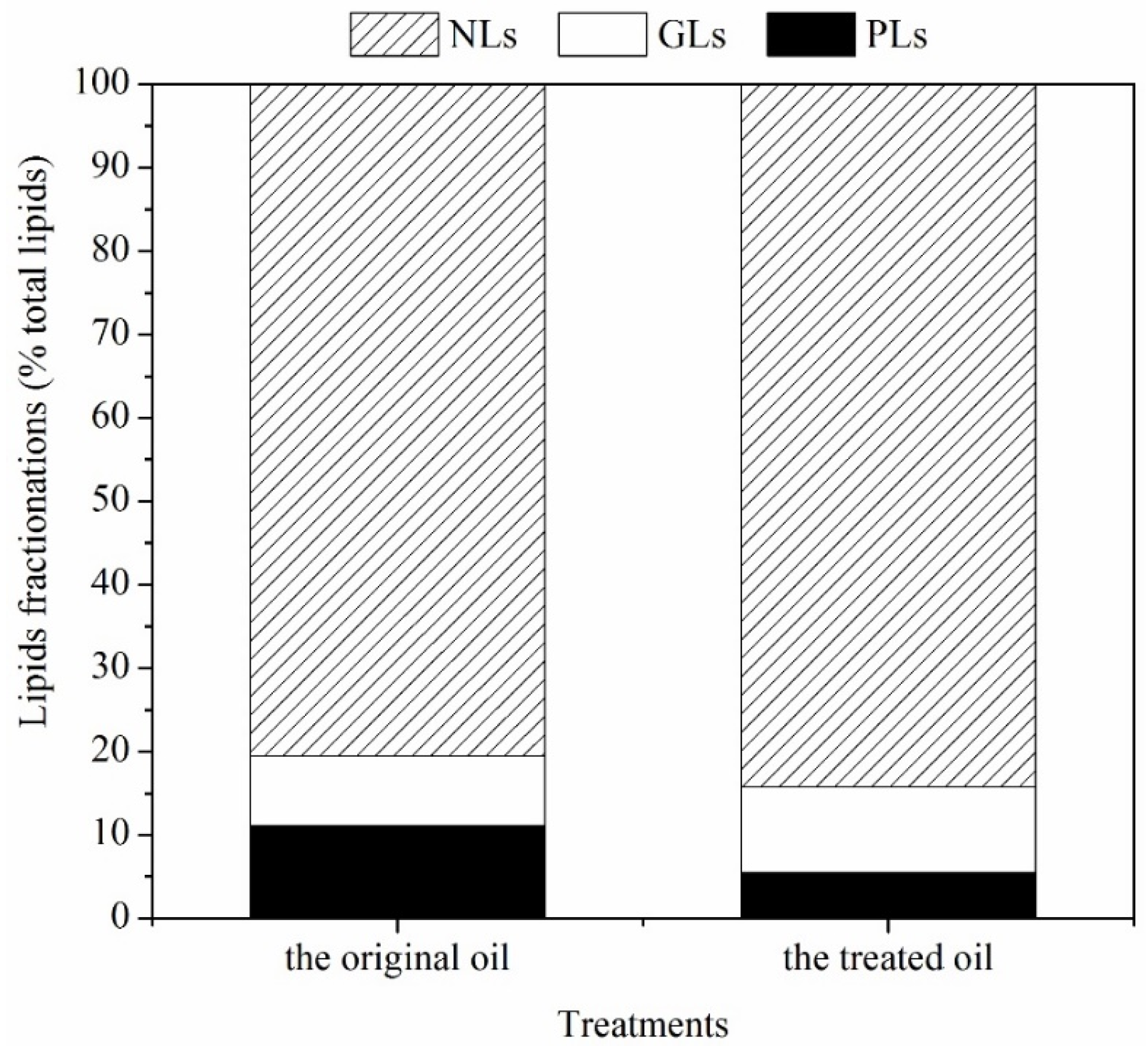
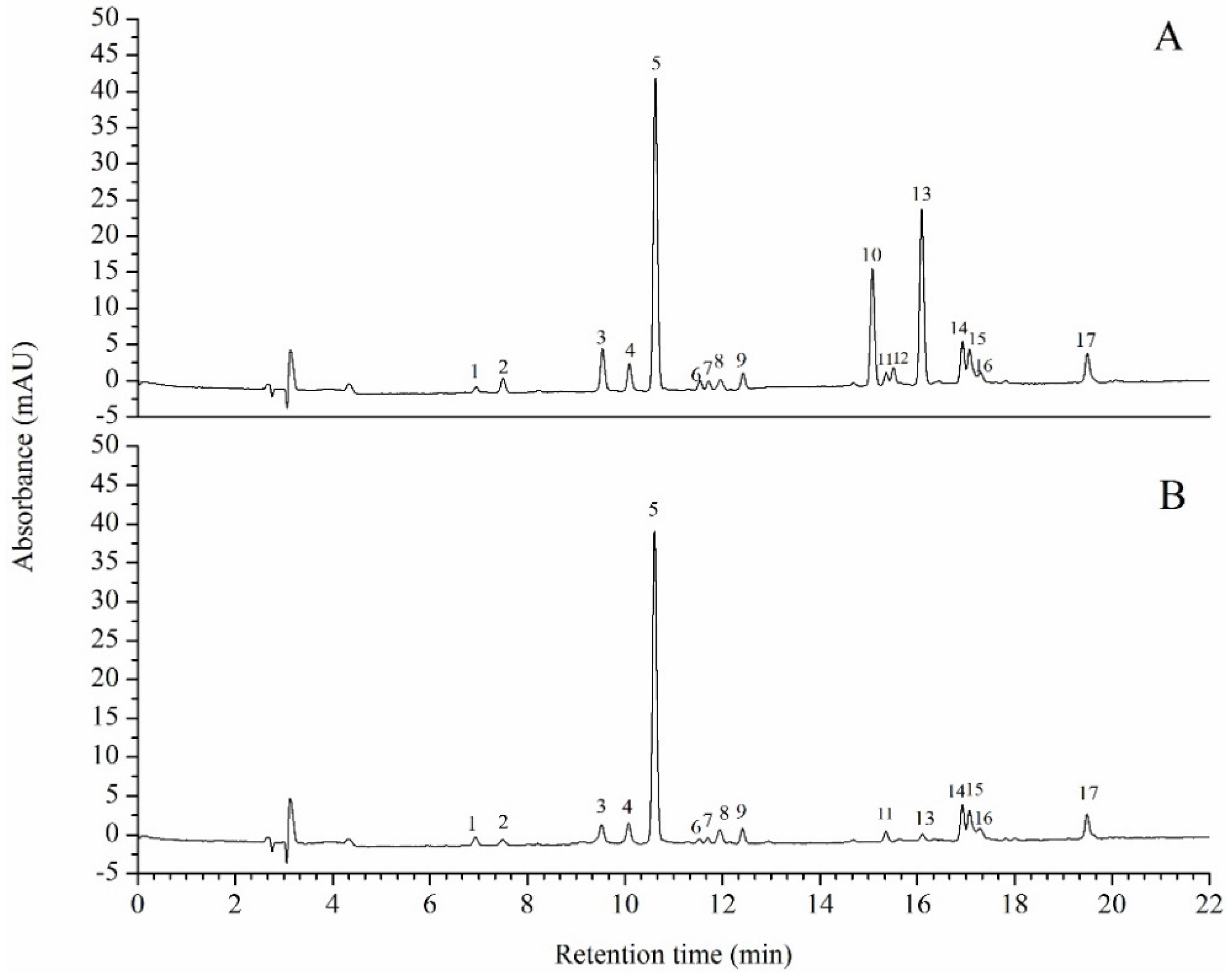
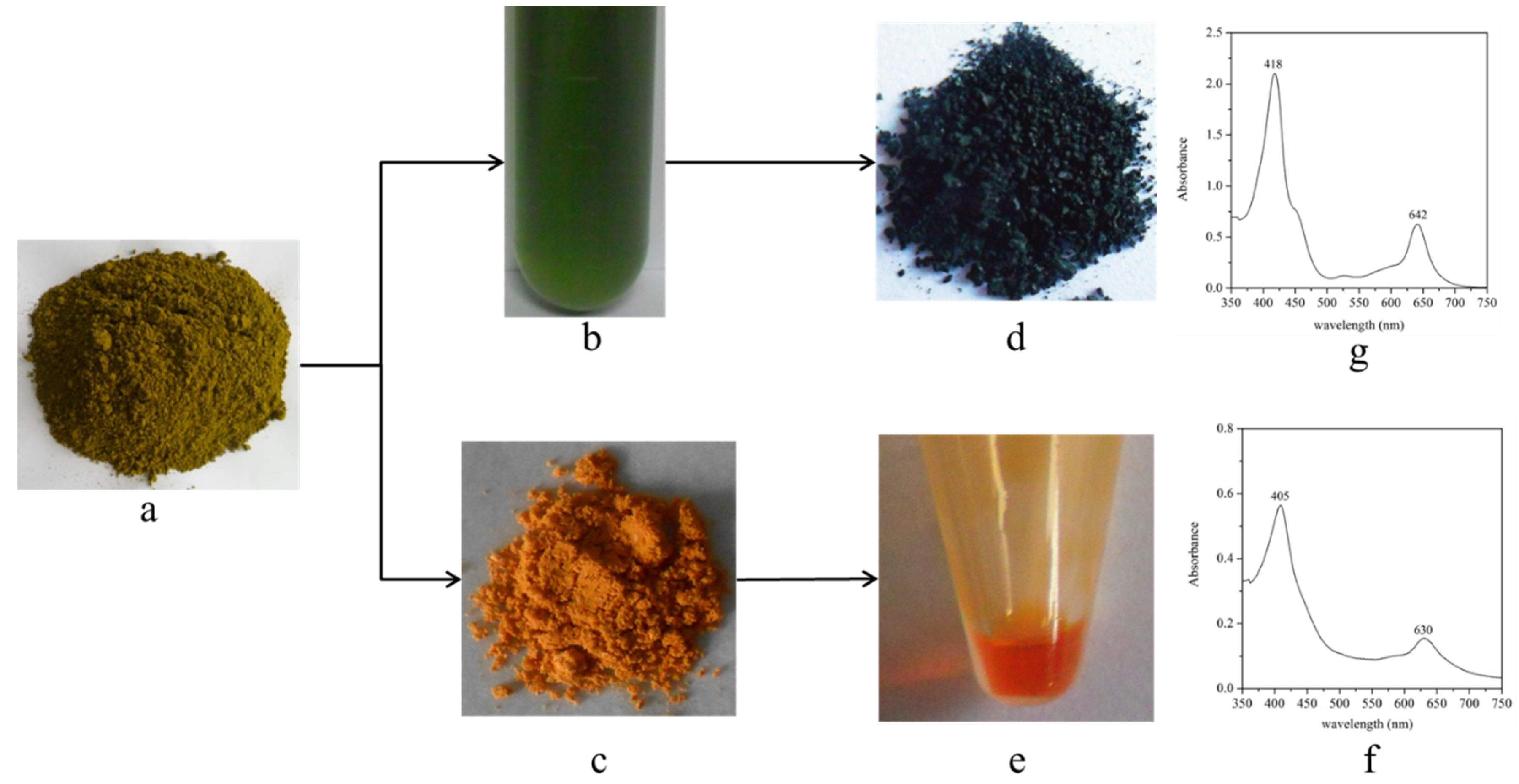
| NLs 2 | GLs 3 | PLs 4 | ||||
|---|---|---|---|---|---|---|
| Untreated Oil (% TFA 1) | De-Chlorophyll Oil (% TFA) | Untreated Oil (% TFA) | De-Chlorophyll Oil (% TFA) | Untreated Oil (% TFA) | De-Chlorophyll Oil (% TFA) | |
| C16:0 | 29.7 ± 0.1 | 27.5 ± 0.1 | 18.4 ± 0.1 | 32.9 ± 0.2 | 42.0 ± 0.4 | 37.8 ± 0.2 |
| C16:1 | 1.9 ± 0.0 | 1.6 ± 0.0 | 1.3 ± 0.0 | 0.7 ± 0.0 | 1.5 ± 0.0 | 1.2 ± 0.0 |
| C16:3 | 2.8 ± 0.0 | 2.5 ± 0.0 | 5.2 ± 0.0 | 0.7 ± 0.0 | 2.4 ± 0.0 | 0.6 ± 0.0 |
| C18:0 | 3.9 ± 0.0 | 4.7 ± 0.0 | 4.4 ± 0.0 | 20.2 ± 0.0 | 2.2 ± 0.0 | 21.2 ± 0.1 |
| C18:1 | 38.9 ± 0.2 | 38.2 ± 0.4 | 37.5 ± 0.4 | 28.5 ± 0.1 | 14.2 ± 0.1 | 22.3 ± 0.2 |
| C18:2 | 8.7 ± 0.0 | 9.5 ± 0.1 | 8.2 ± 0.1 | 6.9 ± 0.0 | 10.3 ± 0.0 | 5.7 ± 0.0 |
| C18:3ω6 | 1.2 ± 0.0 | 1.8 ± 0.0 | 0.2 ± 0.0 | 2.3 ± 0.0 | 0.2 ± 0.0 | 3.2 ± 0.0 |
| C18:3ω3 | 11.4 ± 0.1 | 12.9 ± 0.1 | 24.6 ± 0.2 | 5.5 ± 0.0 | 23.1 ± 0.0 | 5.2 ± 0.0 |
| C20:0 | 0.3 ± 0.0 | 0.2 ± 0.0 | 0.2 ± 0.0 | 2.2 ± 0.0 | 0.1 ± 0.0 | 2.6 ± 0.0 |
| C20:2 | 1.2 ± 0.0 | 1.3 ± 0.0 | n.d. 8 | n.d. 8 | 4.0 ± 0.0 | 0.2 ± 0.0 |
| SFAs 5 | 33.8 ± 0.1 | 32.3 ± 0.1 | 23.0 ± 0.1 | 55.3 ± 0.1 | 44.3 ± 0.3 | 61.6 ± 0.2 |
| MUFAs 6 | 40.8 ± 0.1 | 39.8 ± 0.2 | 38.7 ± 0.2 | 29.2 ± 0.1 | 15.7 ± 0.1 | 23.5 ± 0.1 |
| PUFAs 7 | 25.4 ± 0.1 | 27.9 ± 0.1 | 38.2 ± 0.1 | 15.5 ± 0.0 | 40.0 ± 0.0 | 14.9 ± 0.0 |
| No. | Name of Pigment | Decreased Ratio (%) |
|---|---|---|
| 1 | Violaxanthin | 0 |
| 2 | Neoxanthin | 54.3 ± 1.0 |
| 3 | Canthaxanthin | 48.0 ± 0.3 |
| 4 | Unknown carotenoids | 21.9 ± 0.4 |
| 5 | Lutein | 4.9 ± 0.1 |
| 6 | Zeaxanthin | 58.1 ± 0.7 |
| 7 | Zeaxanthin ester | 50.3 ± 0.2 |
| 8 | Zeaxanthin ester | 0 |
| 9 | Canthaxanthin isomer | 17.6 ± 0.5 |
| 10 | Chlorophyll b | 95.0 ± 0.8 |
| 11 | Chlorophyll a isomer | 7.7 ± 0.4 |
| 12 | Chlorophyll b isomer | 98.5 ± 0.2 |
| 13 | Chlorophyll a | 96.3 ± 1.2 |
| 14 | Astaxanthin ester | 23.6 ± 0.1 |
| 15 | Astaxanthin ester | 15.0 ± 0.4 |
| 16 | Astaxanthin ester | 19.8 ± 0.1 |
| 17 | β-Carotene | 23.8 ± 0.5 |
| Chlorophyll (a + b) | 96.0 ± 0.6 | |
| Total carotenoids | 23.3 ± 0.4 | |
| C16 (% TFA 6) | C18 (% TFA 6) | C20 (% TFA 6) | CN 1 | LCSF 2 | CFPP 3 | IV 4 | SV 5 | |
|---|---|---|---|---|---|---|---|---|
| Original oil | 34.8 ± 0.8 | 63.4 ± 1.3 | 1.7 ± 0.1 | 53.3 ± 0.1 | 0.37 ± 0.02 | −15.3 ± 0.0 | 97.4 ± 0.2 | 195.9 ± 0.5 |
| De-chlorophyll oil | 32.3 ± 0.6 | 66.1 ± 2.0 | 1.6 ± 0.0 | 54.7 ± 0.2 | 0.38 ± 0.01 | −15.3 ± 0.0 | 91.7 ± 0.4 | 195.3 ± 0.3 |
| E1 cm1%405 nm 3 | E405/E630 2 | pH | Yield (per 100 g Biomass) | Purity (%) | |
|---|---|---|---|---|---|
| Prepared SCC 1 sample | 59.0 ± 0.2 | 3.63 ± 0.09 | 8.25 ± 0.01 | 1.88 ± 0.04 | 10.2 ± 0.1 |
| SCC standard (GB26406-2011 2) | ≥568 | 3.2~4.0 | 9.0~10.7 | / | / |
© 2016 by the authors; licensee MDPI, Basel, Switzerland. This article is an open access article distributed under the terms and conditions of the Creative Commons Attribution (CC-BY) license (http://creativecommons.org/licenses/by/4.0/).
Share and Cite
Li, T.; Xu, J.; Wu, H.; Wang, G.; Dai, S.; Fan, J.; He, H.; Xiang, W. A Saponification Method for Chlorophyll Removal from Microalgae Biomass as Oil Feedstock. Mar. Drugs 2016, 14, 162. https://doi.org/10.3390/md14090162
Li T, Xu J, Wu H, Wang G, Dai S, Fan J, He H, Xiang W. A Saponification Method for Chlorophyll Removal from Microalgae Biomass as Oil Feedstock. Marine Drugs. 2016; 14(9):162. https://doi.org/10.3390/md14090162
Chicago/Turabian StyleLi, Tao, Jin Xu, Hualian Wu, Guanghua Wang, Shikun Dai, Jiewei Fan, Hui He, and Wenzhou Xiang. 2016. "A Saponification Method for Chlorophyll Removal from Microalgae Biomass as Oil Feedstock" Marine Drugs 14, no. 9: 162. https://doi.org/10.3390/md14090162
APA StyleLi, T., Xu, J., Wu, H., Wang, G., Dai, S., Fan, J., He, H., & Xiang, W. (2016). A Saponification Method for Chlorophyll Removal from Microalgae Biomass as Oil Feedstock. Marine Drugs, 14(9), 162. https://doi.org/10.3390/md14090162








